The couple offered a million yuan (equivalent to US$ 140,000) as a cash reward to anyone who could assist in finding their son. They also employed buses to travel to nearby towns and provided financial incentives to individuals who offered possible leads.
With the help of artificial intelligence technology in solving the mystery of Xie’s whereabouts, the worried parents were eventually reunited with their now 25-year-old son.
DeepGlint Technology, a Beijing-based AI start-up, credited the successful reunion to its algorithm shortly after the police made the case public. Despite requests for an interview from the South China Morning Post, DeepGlint chose not to participate.
The relentless search for a missing Chinese husband’s child 15 years ago was characterized by persistence and resolve.
By utilizing technology that compared facial features across generations and identified potential relatives, the company stated in a Weibo blog post that Xie was the fifth child they had helped locate in the past six months. The company expressed its commitment to addressing real-world challenges and contributing to societal well-being through AI solutions.
In response to the widespread issue of child abductions and missing children cases, Chinese regulators have partnered with AI companies, allowing access to police databases to deploy various AI models.
The societal preference for children, combined with the previous one-child policy that has since been discontinued, has been cited as a contributing factor to these abductions, leading to the illicit trafficking of children in underground markets.
Although the exact number of rescued children is unknown, the collaboration between law enforcement and AI companies has facilitated the reunion of missing individuals with their families over time.
Jason Liu, an AI and robotics expert based in Shanghai, explained that the technology behind facial recognition is relatively simple and has been around for some time. By analyzing facial features and comparing them for similarities, the AI model can identify potential familial connections, with accuracy improving as more data becomes available.
The recent story of a mother in China reuniting with her missing child after a 32-year search sparked conversations on Weibo, with many users expressing hope that similar technology could help them find their own missing relatives.
While some raised concerns about privacy violations due to AI usage, others highlighted the potential benefits of such technology in locating missing persons and assisting the public.
Zeng Liaoyuan, an associate professor at the University of Electronic Science and Technology of China, warned about the ethical and legal issues surrounding the widespread use of facial recognition technology, stressing the importance of protecting individual privacy.
Given the success stories of AI applications in reuniting families, Zeng called for a thorough discussion on the societal impact and ethical considerations before broad implementation.
Reports indicated that Tencent’s AI lab, YouTu, collaborated with Chinese authorities to create an AI model capable of predicting the appearance of missing children over time. Similarly, in 2016, Baidu developed a program to match uploaded photos with the Ministry of Civil Affairs’ database of missing persons, aiding in the identification and potential reunion of missing individuals.






